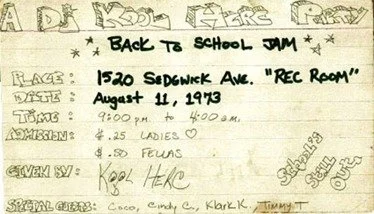The Back to School Event that Changed the World
As August progresses and we look towards the fall, those of us who are parents begin to think about back-to-school preparations and paying for back-to-school supplies. In that spirit, we should also celebrate today, August 11th, as the 50th anniversary of one of the most important back-to-school events in American history: Cindy Campbell's event at 1520 Sedgwick Avenue in the Bronx in 1973. She held the party to raise money to pay for back-to-school clothes. Her brother, Clive Campbell - better known as DJ Kool Herc, DJed the event that is widely considered to be the birth of hip-hop.[1]
DJ Kool Herc is rightly esteemed for his innovation of extending the break sections of songs by alternating between two records of the same song. As a 4 or 8 measure break came to an end, he already had the second record cued up playing in-sync ready to be un-muted so it could continue the beat while he cued and synced the first record back to the beginning of the phrase.
There is a great children’s book about DJ Kool Herc that my children love. The pictures in the book of classic break dance moves got them excited about break dancing. Whenever I play Shades of Blue, Madlib’s classic remix of the Blue Note jazz catalogue, they start break dancing.
When we talk to our children about this historic anniversary, there is a lot more to discuss than DJ Kool Herc developing what he called his "Merry-Go-Round" technique. Like many technologies, DJ Kool Herc’s innovations can also be viewed through W. Brian Arthur’s lens in The Nature of Technology that I discussed in my Mushrooms, etc. newsletter. Scientific, mechanical, cultural, and organizational innovations happen by a re-combination of existing parts within a community.
DJ Kool Herc grew up in Kingston, Jamaica where he saw a tradition of DJs “toasting” over music during dance parties. His family moved to the Bronx when he was 12 and was there during the massive cultural shift that took place after the Hoe Ave Peace Meeting between the street gangs on December 8, 1971.
The documentary Rubble Kings is full of interviews and archival footage explaining the initial context of the intense gang violence that nearly broke out into an all-out war between the gangs after "Black Benjie" of the Ghetto Brothers gang was killed while trying to make peace with the other gangs.[2] Instead of retaliating, the Ghetto Brothers called the Hoe Avenue Peace Meeting that resulted in the signing of the peace treaty by the leaders of the 40 or so gangs who attended.
After the treaty, the strict turf divisions relaxed and the Ghetto Brothers and other gangs began holding block parties where everyone was welcome. Instead of defining their identities by their toughness and power in the gangs, they began to define themselves by their expressions as dancers, graffiti artists, or DJs.[3]
This is the important social context that DJ Kool Herc's innovations at his sister's back-to-school party tapped into. It wasn't just a cool new way to create music, it created space in the music for former gang members to compete and establish themselves in a non-violent ways by showing-off their dance abilities. The concept of a rap battle or dance battle literally evolved as a non-violent alternative to the bloody battles that were happening on the the streets just two years earlier.
As DJ Red Alert said:
Herc had the right timing of presenting something. The same people that was involved in gangs, they felt that they wanna be relieved. They wanna have something that’s theirs. Herc took it upon himself to become their new pied piper.[4]
From that need for release and wanting to have something of their own, the five pillars of hip-hop developed: DJing (aural), MCing (oral), Break Dancing (physical), Graffiti (visual), and Knowledge (mental).[5]
Returning to The Nature of Technology, DJ Kool Herc took the toasting he saw growing up in Jamaica, the growing block party scene at the time, the desire of former gang members to showcase their dance abilities, and his own innovation of extending the instrumental breaks in music and as a result lead the co-creation of hip-hop with others in his community.
When I talk to my children about the birth of hip-hop or other great innovations, whether they be cultural or scientific, this is the understanding I emphasize. If my kids want to create something new or have a positive impact, it is to not only to look inward, but also look around and work within the community to understand what is needed. It is not solely about the individual contribution or all about the community, it is the dialogue between the two.
So let us then celebrate the 50th anniversary of a back-to-school event that reflected and responded to its times times,[6] and provided space for self-expression and relief in order to help solidify peace. From that foundation arose the culture of hip-hop and its five pillars that have given voice to millions around the world.
Notes:
Hill, Laban Carrick, author. When the Beat Was Born : DJ Kool Herc and the Creation of Hip Hop. New York :Roaring Brook Press, 2013.
You can see it free through a kanopy.com account with your local library or find it only here: https://www.justwatch.com/us/movie/rubble-kings
a film by Shan Nicholson. Rubble Kings. [San Francisco, California, USA] :Kanopy Streaming, 2023.
Nicholson. Rubble Kings.
"THE FIVE PILLARS OF HIP-HOP”, Harlem Gallery of Science, https://hgs-ny.org/five-pillar-of-hip-hop.
As Nina Simone said, "An artist’s duty, as far as I’m concerned, is to reflect the times."





